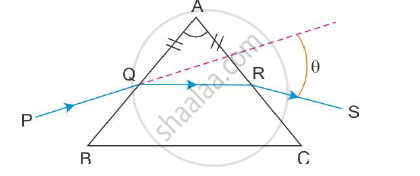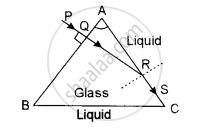Advertisements
Advertisements
Question
What is the cause of dispersion of light
Solution
Cause of dispersion: Different colours of white light have different wavelengths. The wavelength of violet light is smaller than that of red light. The refractive index of a material in terms of the wavelength of the light is given by Cauchy’s expression.
`mu=a+b/lambda^2+c/lambda^4`
Here, a, b and c are constants for the material.
Thus, a material offers different refractive indices to lights of different wavelengths. This is the cause of dispersion of light
RELATED QUESTIONS
Plot a graph to show the variation of the angle of deviation as a function of the angle of incidence for light passing through a prism. Derive an expression for the refractive index of the prism in terms of angle of minimum deviation and angle of the prism.
A ray PQ incident on the refracting face BA is refracted in the prism BAC as shown in the figure and emerges from the other refracting face AC as RS such that AQ = AR. If the angle of prism A = 60° and refractive index of material of prism is `sqrt3 `. Calculate angle θ.

State any two difference between the primary rainbow and secondary rainbow
Can the dispersive power \[\omega = \frac{\mu_u - \mu_r}{\mu - 1}\] be negative? What is the sign of ω if a hollow prism is immersed into water?
If three identical prisms are combined, is it possible to pass a beam that emerges undeviated? Undispersed?
If a glass prism is dipped in water, its dispersive power ___________ .
A prism can produce a minimum deviation δ in a light beam. If three such prisms are combined, the minimum deviation that can be produced in this beam is _______________.
The refractive index of a material M1 changes by 0.014 and that of another material M2 changes by 0.024 as the colour of the light is changed from red to violet. Two thin prisms, one made of M1(A = 5.3°) and the other made of M2(A = 3.7°) are combined with their refracting angles oppositely directed. (a) Find the angular dispersion produced by the combination. (b) The prisms are now combined with their refracting angles similarly directed. Find the angular dispersion produced by the combination.
A narrow beam of monochromatic light, PQ, is incident normally on one face of an equiangular glass prism of refractive index 1.45. When the prism is immersed in a certain liquid, the ray makes a grazing emergence along the other face (See figure). Find the refractive index of this liquid. 
For any prism, obtain a relation between the angle of the prism (A), the angle of minimum deviation (δm) and the refractive index of its material (μ or n).
